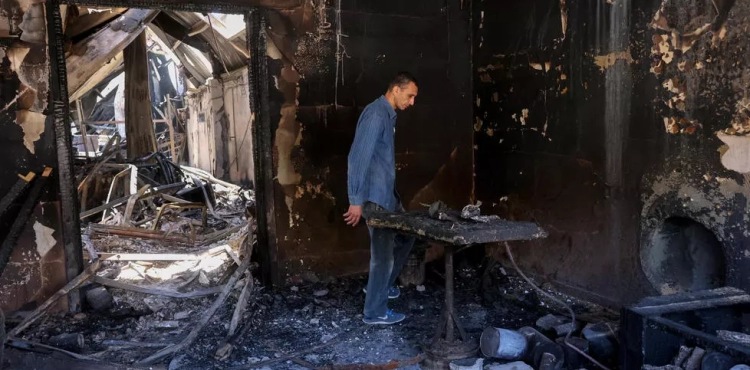The fire, which was set by Israeli artillery shells last Thursday, devoured the largest furniture factory in the Gaza Strip, turning it into rubble within five hours, to mix the furniture ashes with the stones of the roofs and their iron bars that fell to the ground.
The owners of the factory, Iyad and Nihad Al-Sawafiri, were shocked when they saw the remnants of the factory located in the industrial zone in the east of the sector, but they expressed their hope to re-spin the production wheel at the facility in which they said they had invested all their wealth.
"I was very shocked," says Nihad Al Sawafiri, 43, "This is a massacre committed against the factory."
Among the contents were about twenty heavy machines and wooden kitchens prepared for transport to customers, according to what his brother Iyad confirmed.
Iyad says, "We put all our weight and money into the factory on the grounds that it is in the industrial zone as a safe and protected place internationally."
He added surprisingly, "I was sure that the factory would not be harmed, as it is the largest furniture factory here."
But he added, "We have lost millions. We will wait for financial compensation when the reconstruction phase begins."
He expressed his hope that "the factory will be rebuilt and that Israel will not hinder the entry of the huge machines," adding, "They killed our hope."
Israel fully controls the individuals crossing Beit Hanoun (Erez) to the north, and the commercial Kerem Shalom (Kerem Shalom) crossings in the south, as no goods, equipment, machinery, raw materials, etc. enter without Israeli permission.
The industrial zone was established in 1996, in agreement with Israel, two years after the establishment of the Palestinian Authority, to be the first industrial city in the Palestinian territories, on an area of ​​about 500 thousand square meters and includes a large group of local and international industrial and commercial companies, international institutions, government agencies and banks, and about Ten thousand workers.
Among the most prominent facilities are Coca-Cola, another for biscuits, candies, detergents and shampoos, and a factory for plastic tubes.
At the entrance to the closed area, there are UNRWA food aid stores, which were severely damaged during the 2014 war.
In the recent military escalation, several facilities in the industrial zone were damaged, either totally or partially, while other facilities were more fortunate.
In 2021, the industrial zone was provided with a solar power project, with a production capacity of 7.3 megawatts.
The Israeli bombardment also hit the store of the "Al-Siksak Plastic Pipes and Sanitary Ware" company, as the fire destroyed 150 tons of plastic products, in losses estimated at more than one million dollars, according to the company´s director, Naim Al-Saksak.
Al-Siksak tells how a fire broke out near his factory in the industrial zone at the beginning of the war. “We thought it was by mistake,” he says.
He added, “But eight hours before the truce started, the guards told me that a fire broke out in the factory, but the Israeli army refused to bring the Red Cross or Civil Defense to the site” to put it out.
Al-Siksak told AFP that his company owns the largest pipe plant in the Palestinian territories and Israel.
It provides about ninety percent of the pipes of various sizes that are necessary for infrastructure projects, according to Al-Siksak, who pointed out that part of his goods would be supplied to the West Bank.
The sector suffers from a large proportion of pollution in the water.
"When they hit our factory, this is a painful blow to the economy and industry in Palestine," he said, standing in front of his factory and store next to the remains of burnt pipes. "These are goals that have nothing to do with security, factions, or missiles. The industrial zone is agreed upon with Israel."
But he stressed that the production lines in the factory "can work immediately because the machines were not damaged. We can produce 2000 tons per month from different pipes and water tanks, but our actual production is currently only 150 tons."
The Strip, a narrow coastal strip, where about two million people live, a third of them refugees, and Israel has been besieged by land, sea and air for fourteen years, looks like a "time bomb," according to Omar Shaaban, an economic and political analyst, especially since the unemployment rate in the Strip is about 50 per cent. Percent.
Shaaban, director of the "Pal-Think" Foundation for Political and Economic Studies (non-governmental), said that the solution lies in "a political agreement under international sponsorship and work to find sustainable development for the Palestinian economy, rebuilding the Gaza Strip and ending the humanitarian crises that the residents of the Strip suffer, and this requires reconciliation between Hamas and Fatah And political partnership ”.
Shaaban indicated that the United States and the European Union should pressure Israel to lift the blockade imposed on the Strip, stressing that the blockade leads to "more extremism and violence."
The head of the Chamber of Commerce in the Gaza Strip, Walid Al-Hosari, describes what happened as "a major shock in the industrial and economic sector in Gaza. We want stability."
According to Al-Hosari, "It is not difficult to reconstruct what was destroyed if Arab and international financial support is provided."
"It is unacceptable to build, and then destroy Israel every five years," says Al-Siksak.












